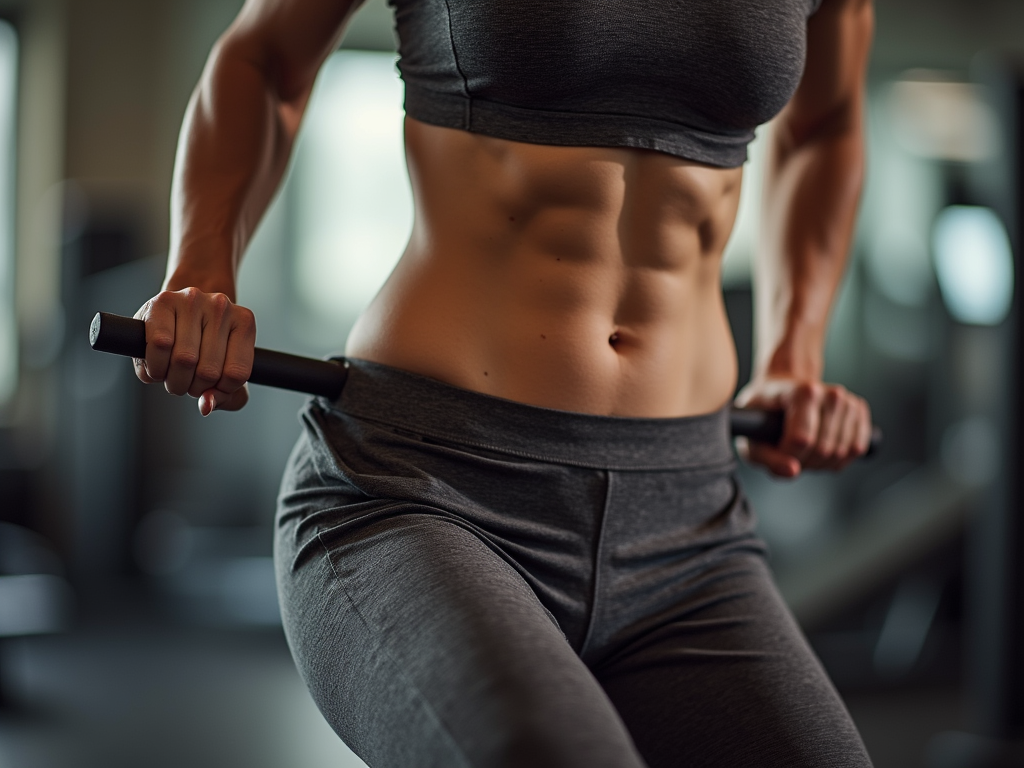I. Introduction
Are you looking to shed those extra pounds and achieve a leaner, healthier body? The key to successful fat loss lies in combining a balanced diet with regular exercise, particularly focusing on cardio workouts. In this article, we will explore the best cardio workouts for fat loss, helping you get started on your journey to a slimmer you.
Cardio exercises are designed to elevate your heart rate and improve cardiovascular health. They not only burn calories during the workout but also boost your metabolism, aiding in sustained weight loss over time. Here are some of the most effective cardio workouts that can help you achieve your fat loss goals:
- High-Intensity Interval Training (HIIT): This involves short bursts of high-intensity exercise followed by brief periods of rest. HIIT is incredibly effective for burning calories and improving insulin sensitivity.
- Running: Whether it’s on a treadmill or outdoors, running is one of the most straightforward ways to get your heart pumping and burn fat quickly.
- Cycling: Stationary cycling or using a spin bike at home can be just as effective as running when it comes to cardiovascular benefits.
- Swimming: A low-impact exercise that’s easy on the joints yet highly efficient for burning calories.
- Jumping Rope: A classic childhood activity that’s now recognized as an excellent full-body workout for fat loss.
- Rowing Machine: Another low-impact option that targets multiple muscle groups while providing an intense cardiovascular challenge.
In addition to these specific exercises, incorporating interval training into your routine can significantly enhance its effectiveness. This involves alternating between periods of high-intensity exercise and lower-intensity recovery periods. For example, you might alternate between sprinting and walking or between burpees and push-ups.
Remember, consistency is key when it comes to achieving fat loss through cardio workouts. Aim for at least three sessions per week, each lasting around 30 minutes or more if you’re just starting out. As you progress, you can gradually increase both frequency and duration.
It’s also important not just focus on physical activity but also maintain a balanced diet rich in nutrients while minimizing processed foods high in sugar and unhealthy fats. A combination of healthy eating habits along with regular cardio workouts will yield better results than relying solely on one aspect alone.
So why wait? Start incorporating these best cardio workouts for fat loss into your daily routine today Whether you’re looking for quick results or long-term sustainability, these exercises will help you achieve your fitness goals while keeping you engaged throughout the journey.
Stay motivated by tracking your progress through apps like MyFitnessPal or Fitbit Coach which offer personalized workout plans tailored specifically towards achieving optimal weight management through various forms including but not limited to cardio exercises.
Remember always consult with healthcare professionals before beginning any new exercise regimen especially if you have pre-existing medical conditions ensuring safety throughout entire process
II. Top 5 Cardio Workouts for Fat Loss
A. High-Intensity Interval Training
High-Intensity Interval Training (HIIT) is one of the best cardio workouts for fat loss. This method involves short bursts of high-intensity exercise followed by brief periods of rest or low-intensity exercise. HIIT can be applied to various exercises such as sprints, burpees, jump squats, and mountain climbers. It’s highly effective because it boosts your metabolism and burns calories efficiently.
B. Running
Running is another excellent cardio workout for fat loss. It’s a low-cost activity that can be done almost anywhere. Whether you’re a beginner or an experienced runner, incorporating running into your routine can significantly improve your cardiovascular health and help you shed pounds. For those who are new to running, starting with shorter distances and gradually increasing them is recommended.
C. Swimming
Swimming is a low-impact cardio workout that’s perfect for those who want to avoid high-impact activities on their joints. It’s also an excellent way to build endurance and burn calories without putting excessive strain on your body. Swimming laps at a moderate pace can be very effective for fat loss, especially when combined with strength training exercises.
D. Cycling
Cycling is another versatile cardio workout that can be done indoors or outdoors using a stationary bike or a road bike. It’s easy on the joints and provides an excellent full-body workout when combined with resistance training. For those looking to lose fat quickly, incorporating interval training into their cycling routine can be highly beneficial.
E. Jumping Rope
Jumping rope is a high-intensity cardio exercise that’s portable and inexpensive. It’s an excellent way to improve cardiovascular fitness while burning calories efficiently. Jumping rope can be done anywhere, making it a great option for those who travel frequently or prefer working out at home.
F. Comparison of Cardio Workouts
| Workout | Caloric Burn per Hour | Impact Level | Equipment Needed |
|---|---|---|---|
| High-Intensity Interval Training (HIIT) | 600-800 calories/hour | High | None (bodyweight exercises) |
| Running | 400-600 calories/hour | High | Sneakers |
| Swimming | 450-650 calories/hour | Low | Swimwear and goggles |
| Cycling | 400-600 calories/hour | Low-Moderate | Stationary bike or road bike |
| Jumping Rope | 700-900 calories/hour | High | Jump rope |
G. Conclusion
The best cardio workouts for fat loss often involve a combination of high-intensity exercises and interval training. Whether you choose HIIT, running, swimming, cycling, or jumping rope, incorporating these activities into your routine can significantly improve your overall fitness level and aid in weight loss. Always remember to consult with a healthcare professional before starting any new exercise program.
For more detailed information on how these workouts can be tailored to your specific needs and goals, visit Healthline’s guide on cardio workouts for fat loss.

**Quote:** “High-intensity interval training is my go-to for shedding those extra pounds.”
III. High-Intensity Interval Training
A. What is HIIT?
High-Intensity Interval Training (HIIT) is a type of workout that involves short bursts of high-intensity exercise followed by brief periods of rest or low-intensity exercise. This pattern can be repeated for a variety of exercises, making it an effective way to improve cardiovascular fitness and burn fat efficiently. The best cardio workouts for fat loss often incorporate HIIT due to its ability to boost metabolism and enhance caloric expenditure.
B. Benefits of HIIT
The benefits of HIIT are numerous and well-documented. Here are some key advantages:
- Time-Efficient: HIIT workouts are typically shorter than traditional cardio sessions, making them ideal for busy schedules.
- Improved Cardiovascular Health: Regular HIIT sessions can significantly improve heart health by increasing blood flow and reducing blood pressure.
- Enhanced Metabolism: HIIT workouts have been shown to boost resting metabolic rate (RMR), helping your body burn more calories at rest.
- Increased Caloric Burn: Due to the high-intensity nature, HIIT burns more calories during the workout compared to steady-state cardio.
- Mental Benefits: The varied nature of HIIT workouts keeps your mind engaged, reducing boredom and increasing motivation.
C. Sample HIIT Workout Routines
Here’s a sample HIIT workout routine that you can follow:
Warm-Up: 5 minutes of light cardio (jogging, jumping jacks, etc.)
Workout Routine:
| Exercise | Duration | Rest Time | |———-|———-|———–| | Sprints | 30 seconds| 30 seconds| | Burpees | 30 seconds| 30 seconds| | Jump Squats | 30 seconds | 30 seconds | | Mountain Climbers | 30 seconds | 30 seconds | | Plank Hold | 30 seconds | 30 seconds |
Cool Down: 5 minutes of stretching
Remember to listen to your body and adjust the intensity and duration based on your fitness level. It’s also important to include proper warm-up and cool-down routines in your HIIT sessions.
For more detailed information on how HIIT can be tailored for different fitness levels and goals, check out this article from Healthline.
By incorporating HIIT into your fitness routine, you’ll not only achieve best cardio workouts for fat loss but also enjoy numerous other health benefits associated with high-intensity interval training.

**”High-intensity interval training is my go-to for burning belly fat. It’s like a punch in the gut, but in a good way!”** – **Lena Thompson, Personal Trainer**
IV. Running for Fat Loss
A. Types of Running Workouts
When it comes to running for fat loss, understanding the different types of workouts can help you tailor your routine to your goals. Here are some common types:
- High-Intensity Interval Training (HIIT): This involves short bursts of high-intensity running followed by brief periods of rest or low-intensity exercise.
- Long-Distance Running: This type involves longer runs at a steady pace, often used for endurance training.
- Interval Training: Similar to HIIT but with more structured intervals.
- Tempo Runs: These are steady-state runs at a moderate to high intensity.
Each type has its own benefits and can be effective depending on your fitness level and goals.
B. How to Incorporate Running into Your Routine
Incorporating running into your routine requires careful planning and consistency. Here are some tips:
- Start Slow: Begin with shorter distances and gradually increase as you build endurance.
- Warm Up and Cool Down: Always warm up before running with light cardio or stretching, and cool down afterwards to prevent injuries.
- Listen to Your Body: Pay attention to your body’s signals; if you’re feeling tired or experiencing pain, it’s okay to take a rest day.
- Track Your Progress: Use a running app or log to track your progress, including distance, time, and heart rate.
Consistency is key when it comes to seeing results from running for fat loss.
C. Safety Tips for Runners
Running can be safe if you follow some basic safety tips:
- Choose Safe Routes: Avoid running in isolated areas and opt for well-lit routes with minimal traffic.
- Wear Proper Gear: Invest in good quality running shoes and comfortable clothing suitable for the weather conditions.
- Stay Hydrated: Drink plenty of water before, during, and after your runs to avoid dehydration.
- Run with a Buddy: Running with a friend or family member can be safer and more enjoyable.
Additionally, always consult with a healthcare professional before starting any new exercise program.
For more detailed information on how to incorporate running into your routine effectively, check out this article on Healthline.
Best Cardio Workouts for Fat Loss
Running is an excellent cardio workout for fat loss due to its high caloric expenditure per hour compared to other forms of exercise. Here are some reasons why running stands out:
| Workout Type | Caloric Expenditure (per hour) |
|---|---|
| Running | 600-800 calories |
| Swimming | 450-600 calories |
| Cycling | 400-550 calories |
While other cardio workouts like swimming and cycling are also effective, running offers unique benefits such as improved cardiovascular health and increased muscle strength in the legs.
Here’s a sample weekly routine incorporating running workouts:
- Monday: HIIT Session – 30 minutes of alternating between sprints and jogs.
- Wednesday: Long-Distance Run – 45 minutes at a steady pace.
- Friday: Interval Training – 30 minutes with varying intervals of high-intensity running.
Remember to include rest days in your schedule to allow your body time to recover.
By incorporating these tips into your routine, you’ll be well on your way towards achieving your fat loss goals through running.

**”High-intensity interval training is my go-to for shedding those extra pounds. It’s like a punch to the fat, and it keeps me on my toes!”** – **Alex Chen, Personal Trainer**
V. Swimming as a Cardio Workout
A. Why Swimming is Effective for Fat Loss
Swimming is one of the best cardio workouts for fat loss because it offers a full-body exercise that engages multiple muscle groups simultaneously. This comprehensive approach to exercise helps burn calories efficiently and effectively. Unlike other forms of cardio, swimming does not put excessive strain on joints, making it an ideal option for those who are overweight or have joint issues.
Moreover, swimming improves cardiovascular health by increasing heart rate and blood flow, which enhances overall fitness levels. Regular swimming sessions can also boost metabolism, aiding in sustained weight loss over time.
B. Swimming Techniques for Beginners
For those new to swimming, understanding proper techniques is crucial to maximize benefits while minimizing risk of injury. Here are some key techniques to focus on:
– **Breathing**: Proper breathing technique is essential in swimming. Beginners should practice breathing every 2-3 strokes to maintain a steady rhythm. – **Strokes**: The most common strokes include freestyle (front crawl), backstroke, breaststroke, and butterfly. Each stroke has its own unique movement patterns that should be mastered gradually. – **Body Position**: Keeping your body streamlined reduces drag and conserves energy. Engage your core muscles to maintain a straight line from head to heels. – **Kick**: A strong kick helps propel you through the water efficiently. Focus on using your hips rather than just your legs.
C. Home Swimming Workouts
While many people prefer going to a pool for their swimming workouts, it’s also possible to do effective swimming exercises at home with minimal equipment:
### Using a Pool
If you have access to a pool, here’s how you can create an effective home workout:
| Exercise | Description | |———-|————-| | Freestyle Swimming | Swim laps at moderate intensity for 20-30 minutes. | | Backstroke Swimming | Swim laps at moderate intensity for 20-30 minutes. | | Breaststroke Swimming | Swim laps at moderate intensity for 20-30 minutes. | | Butterfly Swimming | Swim laps at moderate intensity for 20-30 minutes. |
### Without a Pool
If you don’t have access to a pool, there are still several exercises you can do at home that mimic swimming movements:
– **Arm Circles**: Hold your arms straight out to the sides and make small circles with your hands. – **Leg Kicks**: Lie on your back and kick one leg at a time as if you were swimming. – **Waterless Swimming**: Use resistance bands or light dumbbells while performing arm strokes in place.
### Tips for Effective Home Workouts
1. **Warm-Up**: Always start with a 5-minute warm-up session involving light cardio such as jogging in place or jumping jacks. 2. **Cool Down**: Finish each session with a 5-minute cool-down involving static stretches focusing on major muscle groups like arms, legs, and back. 3. **Consistency**: Aim for at least three sessions per week for optimal results.
By incorporating these techniques into your routine, you’ll find that swimming becomes an enjoyable yet challenging way to achieve best cardio workouts for fat loss. For more detailed information on how swimming can help with weight loss, check out this article from [Healthline](www.healthline.com/nutrition/swimming-for-weight-loss).

**”High-intensity interval training is my go-to for burning fat and boosting metabolism.” – Dr. Rachel Thompson, Fitness Coach**
VI. Cycling for Cardio Fitness
A. Types of Cycling Workouts
Cycling is an excellent cardio workout for fat loss, and it comes in various forms to suit different fitness levels and preferences. Here are some popular types of cycling workouts:
- Stationary Bike: Also known as an exercise bike or spin bike, this is a great option for home workouts or gym sessions.
- Outdoor Cycling: Riding a bike outdoors offers a change of scenery and can be more engaging than stationary cycling.
- Spin Class: A group fitness class that combines high-intensity interval training (HIIT) with cycling.
- Mountain Biking: For those who enjoy off-road terrain, mountain biking provides an intense workout.
B. Tips for Effective Cycling Sessions
To maximize the benefits of cycling for fat loss, follow these tips:
- Set Goals: Define your goals whether it’s to lose weight or improve cardiovascular health.
- Warm Up: Always start with a 5-10 minute warm-up session to prevent injuries and get your heart rate up.
- High-Intensity Intervals: Incorporate HIIT into your routine by alternating between high-intensity sprints and low-intensity recovery periods.
- Monitor Progress: Use a heart rate monitor or app to track your progress and adjust your workout accordingly.
C. Equipment Needed for Cycling
While you can start with minimal equipment, investing in the right gear can enhance your cycling experience:
| Equipment | Description |
|---|---|
| Exercise Bike | A stationary bike designed for indoor workouts, often equipped with features like adjustable resistance and heart rate monitoring. |
| Cycling Shoes | Specialized shoes with clipless pedals that provide better support and efficiency during pedaling. |
| Helmet | A must-have for safety when riding outdoors, especially on roads or trails. |
For those looking to take their cycling to the next level, consider investing in additional accessories such as water bottles, bike lights, or a cycling computer.
Remember to always check out reputable sources like Healthline for more detailed information on how cycling can be an effective cardio workout for fat loss.
By incorporating these tips and using the right equipment, you’ll be well on your way to achieving your fitness goals through cycling.
Whether you’re a beginner or an experienced cyclist, remember that consistency is key. Aim to cycle at least three times a week and gradually increase your intensity and duration as you progress.
With its low-impact nature and versatility in terms of intensity levels and types of workouts available, cycling is an excellent choice for anyone looking to improve their cardiovascular fitness while losing fat effectively.
So why not give it a try? Hop on your bike today and start pedaling towards a healthier you!

**”High-intensity interval training is my go-to for burning fat and boosting metabolism.” – Emily Wilson, Personal Trainer**
VII. Jumping Rope: A High-Impact Cardio Option
A. Benefits of Jumping Rope
Jumping rope is one of the best cardio workouts for fat loss due to its high-intensity nature and versatility. It offers numerous benefits that make it an excellent addition to any fitness routine. Here are some key advantages:
- Calorie Burner: Jumping rope can burn up to 700 calories per hour, making it an effective way to lose weight and improve overall fitness.
- Improved Cardiovascular Health: Regular jumping rope sessions can enhance cardiovascular health by increasing heart rate and improving circulation.
- Enhanced Coordination and Agility: The repetitive motion of jumping rope improves coordination, balance, and agility.
- Low-Impact on Joints: Unlike high-impact activities like running or jumping, rope jumping is relatively low-impact on joints, making it accessible for people with joint issues.
For those looking to incorporate high-intensity interval training (HIIT) into their routine, jumping rope is an excellent choice. HIIT involves short bursts of intense exercise followed by brief periods of rest or low-intensity exercise. This type of training has been shown to be highly effective for fat loss and improving metabolic function.
B. How to Master Jumping Rope Techniques
To get the most out of jumping rope, it’s essential to master proper techniques. Here are some tips:
- Choose the Right Rope: Select a rope that suits your skill level and personal preference. There are various types available including speed ropes, heavy ropes, and adjustable ropes.
- Start with Basic Techniques: Begin with basic jumps like single unders (one jump per rotation) and double unders (two jumps per rotation). Practice these until you feel comfortable.
- Focus on Footwork: Pay attention to your footwork; keep your knees slightly bent and land softly on the balls of your feet.
- Use Proper Grip: Hold the handles firmly but not too tightly; this will help maintain control throughout the workout.
For beginners, it’s helpful to start with shorter sessions and gradually increase duration as you build endurance. You can also incorporate different rhythms like alternating between single unders and double unders or adding in some plyometric jumps for added intensity.
C. Variations in Jumping Rope Workouts
While traditional jumping rope is effective, there are several variations you can incorporate into your routine to keep things interesting and challenging:
- Timed Intervals: Set timers for specific intervals (e.g., 30 seconds) followed by rest periods. This format mimics HIIT workouts.
- Distance Jumps: Measure out specific distances on the floor or track and aim to complete a certain number of jumps within that distance.
- Jumping Rope with Weights: Add weights or resistance bands to increase the intensity of your workout.
- Jumping Rope with Music: Create playlists with different rhythms to keep your workouts engaging and fun.
For those looking for more advanced techniques, consider incorporating jumping rope with burpees or other compound exercises like squats and lunges into your routine. These combinations will not only improve cardiovascular fitness but also enhance strength training.
Remember, consistency is key when it comes to seeing results from any exercise regimen including jumping rope workouts. Aim to perform at least three times per week and mix up your routine regularly to avoid plateaus.
For more detailed information on how to incorporate jumping rope into your HIIT routine, check out this article from Healthline.
| Workout Type | Description | Intensity Level |
|---|---|---|
| Traditional Jumping Rope | Basic single or double unders. | Medium-High |
| Timed Intervals | 30-second intervals with rest periods. | High |
| Distance Jumps | Measuring specific distances for completion. | Medium-High |
| Jumping Rope with Weights | Adding weights for increased resistance. | High |
By incorporating these variations into your routine, you’ll find that jumping rope remains an exciting and challenging way to achieve best cardio workouts for fat loss. Whether you’re a beginner or an advanced athlete looking for new challenges, there’s always room for improvement with this versatile exercise.

**”High-intensity interval training is my go-to for burning fat and boosting metabolism.” – Emily Chen, Personal Trainer**
VIII. Combining Cardio with Strength Training
A. Why Combine Cardio with Strength
Combining cardio and strength training is a highly effective way to achieve your fitness goals, particularly when it comes to fat loss. **Best cardio workouts for fat loss** often involve high-intensity interval training (HIIT), which can be incredibly efficient in burning calories and improving cardiovascular health. By incorporating strength training into your routine, you not only enhance muscle mass but also boost your metabolism, making it easier to shed those extra pounds.
Here are some compelling reasons why you should combine both:
- Improved Metabolism: Strength training helps build muscle, which increases your resting metabolic rate, meaning you burn more calories at rest.
- Enhanced Cardiovascular Health: Regular cardio exercises improve heart function and reduce the risk of heart disease.
- Better Weight Management: Combining both types of workouts helps maintain muscle mass while losing fat, leading to a more toned physique.
B. Sample Workout Routines Combining Both
Here’s a sample workout routine that combines both cardio and strength training:
**Warm-Up (10 minutes)**
- Light jogging or cycling
- Dynamic stretching (leg swings, arm circles, etc.)
**Monday (Chest and Triceps)**
- Bench Press (3 sets of 8-12 reps)
- Incline Dumbbell Press (3 sets of 10-15 reps)
- Tricep Pushdowns (3 sets of 10-12 reps)
- Tricep Dips (3 sets of 12-15 reps)
**Cardio Segment (20 minutes)**
- High-Intensity Interval Training (HIIT): Sprints or burpees for 30 seconds followed by a 30-second rest period.
**Tuesday (Back and Biceps)**
- Deadlifts (3 sets of 8-12 reps)
- Bent-Over Barbell Rows (3 sets of 8-12 reps)
- Dumbbell Bicep Curls (3 sets of 10-12 reps)
- Hammer Curls (3 sets of 10-12 reps)
**Cardio Segment (20 minutes)**
- Steady-State Cardio: Jogging or cycling at a moderate intensity.
**Wednesday (Rest Day)**
**Thursday (Legs)**
- Squats (3 sets of 8-12 reps)
- Leg Press (3 sets of 10-12 reps)
- Lunges (3 sets per leg)
- Calf Raises (3 sets of 12-15 reps)
**Cardio Segment (20 minutes)**
- Rowing Machine: A full-body workout that engages both your upper body and legs.
**Friday (Shoulders and Abs)**
- Shoulder Press (3 sets of 8-12 reps)
- Lateral Raises (3 sets of 10-12 reps)
- Plank (hold for 30-60 seconds)
- Russian Twists (3 sets per side)
**Cardio Segment (20 minutes)**
- Jumping Rope: An excellent cardio exercise that targets your entire body.
C. Benefits of Full Body Workouts
Full body workouts offer numerous benefits when combined with cardio exercises:
- Time Efficiency: By targeting multiple muscle groups at once, you save time compared to focusing on individual muscle groups.
- Improved Coordination: Full body exercises often require coordination between different muscle groups, enhancing overall physical fitness.
- Enhanced Metabolism: As mentioned earlier, building muscle through strength training increases your resting metabolic rate, helping you burn more calories at rest.
For more detailed information on how to incorporate HIIT into your routine, check out this article from Healthline on **best cardio workouts for fat loss**.
| Workout Type | Description | Duration |
|---|---|---|
| HIIT | High-intensity interval training involving short bursts of intense exercise followed by brief periods of rest. | 20-30 minutes |
| Steady-State Cardio | Continuous moderate-intensity exercise such as jogging or cycling. | 30-45 minutes |
| Full Body Workouts | Exercises that target multiple muscle groups simultaneously such as squats, deadlifts, bench press etc. | 30-60 minutes |
Remember to always warm up before starting any workout routine and cool down afterwards to prevent injuries and promote recovery.
By combining cardio with strength training, you’ll not only achieve better results in terms of fat loss but also enhance overall physical fitness and well-being

**”High-intensity interval training (HIIT) is like a fire that burns fat—once you start, it’s hard to stop!” – Rachel Thompson, Personal Trainer**
IX. Incorporating Cardio into Your Daily Routine
A. Morning vs Evening Workouts
When it comes to best cardio workouts for fat loss, timing can play a significant role in your overall fitness goals. Both morning and evening workouts have their advantages, but which one is better for you?
**Morning Workouts:** – Improved Mental Clarity: Exercising in the morning can help increase your alertness and mental clarity throughout the day. – Less Distractions: The morning is often less crowded, providing a more peaceful environment for your workout. – Boosted Metabolism: Starting your day with exercise can kickstart your metabolism, helping you burn more calories throughout the day.
**Evening Workouts:** – Relaxation and Stress Relief: After a long day, an evening workout can help reduce stress and promote better sleep. – Increased Energy Levels: While it might seem counterintuitive, some people find that exercising in the evening actually increases their energy levels before bed. – Convenience for Busy Schedules: For those with busy schedules, evening workouts might be more feasible as they can be done after work or school.
B. How to Make Time for Cardio in Busy Schedules
With modern lifestyles often filled with work, family, and other commitments, finding time for best cardio workouts for fat loss can be challenging. Here are some tips to help you incorporate cardio into your busy schedule:
- Start Small: Begin with short sessions of 10-15 minutes and gradually increase the duration as you become more comfortable.
- High-Intensity Interval Training (HIIT): This type of workout involves short bursts of intense exercise followed by brief periods of rest. It’s efficient and can be done in just a few minutes.
- Home Workouts: Bodyweight exercises like push-ups, squats, and lunges are great alternatives to gym workouts and can be done anywhere.
- Use Technology: There are numerous apps and online platforms that offer quick and effective cardio routines you can follow at home.
For example, you can try home workout apps that provide structured routines tailored for busy individuals.
C. Tips for Sticking to Your Routine
Consistency is key when it comes to achieving your fitness goals. Here are some tips to help you stick to your best cardio workouts for fat loss routine:
- Set Realistic Goals: Aim for achievable goals rather than setting yourself up for disappointment by trying too much too soon.
- Track Your Progress: Use a fitness tracker or log your workouts to monitor your progress and stay motivated.
- Find a Workout Buddy: Exercising with a friend or family member can make the experience more enjoyable and help you stay accountable.
- Make It Fun: Experiment with different types of cardio workouts until you find one that you enjoy. This will make sticking to the routine much easier.
Remember, incorporating best cardio workouts for fat loss into your daily routine takes time and effort but is worth it in the long run. By finding a balance that works for you and staying consistent, you’ll be on your way to achieving your fitness goals.
| Workout Type | Description | Duration |
|---|---|---|
| High-Intensity Interval Training (HIIT) | Short bursts of intense exercise followed by brief periods of rest. | 15-30 minutes |
| Running | Continuous aerobic exercise. | 30-60 minutes |
| Cycling | Aerobic exercise using a stationary bike or outdoor cycling. | 30-60 minutes |
| Swimming | Aerobic exercise using various strokes in water. | 20-40 minutes |
By incorporating these tips into your daily routine and choosing the right type of cardio workout, you’ll be well on your way to achieving your fat loss goals.

**”High-intensity interval training is my go-to for shedding those extra pounds. It’s like a dance party for your heart!” – Emily Chen, Personal Trainer**
X. Common Mistakes to Avoid in Cardio Workouts
A. Overtraining Risks
One of the most significant mistakes individuals make when engaging in best cardio workouts for fat loss is overtraining. Overtraining occurs when you push your body too hard, leading to prolonged periods of high-intensity exercise without adequate rest and recovery time. This can result in fatigue, decreased performance, and increased risk of injury.
Signs of overtraining include persistent fatigue, decreased motivation, and reduced performance in workouts. It’s crucial to listen to your body and take rest days as needed. Aim for a balanced routine that includes both high-intensity interval training (HIIT) and steady-state cardio sessions.
B. Poor Form Techniques
Poor form techniques are another common mistake that can lead to ineffective workouts and potential injuries. For example, during exercises like burpees or jump squats, maintaining proper form is essential. If you’re not using correct techniques, you may end up putting unnecessary strain on your joints or muscles.
Here are some key points to focus on when it comes to form:
- Proper Posture: Maintain good posture throughout your workout to ensure that you’re engaging the right muscles.
- Controlled Movements: Avoid jerky or bouncy movements; instead, focus on smooth and controlled transitions between exercises.
- Engaged Core: Keep your core muscles engaged to provide stability and support during dynamic movements.
C. Inadequate Warm-Up/ Cool-Down
An inadequate warm-up or cool-down routine can significantly impact the effectiveness of your best cardio workouts for fat loss. A proper warm-up prepares your muscles for physical activity by increasing blood flow and temperature in the muscles, reducing the risk of injury.
A good warm-up should include light cardio such as jogging in place or jumping jacks followed by dynamic stretching like leg swings and arm circles. On the other hand, a cool-down helps in gradually bringing down your heart rate and reducing muscle soreness post-workout.
Here’s an example of a simple warm-up routine:
| Exercise | Description |
|---|---|
| Jogging in Place | 30 seconds |
| Jumping Jacks | 30 seconds |
| Leg Swings (front and back) | 30 seconds each leg |
| Arm Circles (forward and backward) | 30 seconds each arm |
For a cool-down routine, you can include static stretches targeting major muscle groups like hamstrings, quadriceps, hip flexors, and chest muscles.
Here’s an example of a simple cool-down routine:
- Hamstring Stretch: Stand with your feet shoulder-width apart then bend forward at the hips until you feel a stretch in the back of your legs.
- Quadriceps Stretch: Stand with one hand against a wall for balance then bend one knee behind you until you feel a stretch in the front of your leg.
- Hip Flexor Stretch: Kneel on all fours then bring one knee forward so that your ankle is near your opposite hip.
- Chest Stretch: Stand in a doorway with your hands on the doorframe at shoulder height then lean forward until you feel a stretch in your chest muscles.
Remember to hold each stretch for at least 20-30 seconds and breathe deeply while stretching.
By avoiding these common mistakes—overtraining risks, poor form techniques, and inadequate warm-up/cool-down routines—you’ll be able to maximize the effectiveness of your best cardio workouts for fat loss while minimizing the risk of injury or burnout.
For more detailed information on how to incorporate these principles into your workout routine, check out this article from Healthline which provides comprehensive tips on designing an optimal cardio routine.

**”High-intensity interval training is my go-to for burning fat quickly. It’s like a sprint in the gym!” – Rachel Thompson, Personal Trainer**
XI. Nutrition Tips for Enhanced Fat Loss
A. Balanced Diet Essentials
A balanced diet is crucial for achieving and maintaining weight loss. It involves consuming a variety of nutrient-dense foods including fruits, vegetables, whole grains, lean proteins, and healthy fats. A well-balanced diet helps in maintaining energy levels and supports overall health.
B. Macronutrient Ratios for Fat Loss
When it comes to fat loss, understanding macronutrient ratios is essential. Generally, a balanced diet should include:
- Protein: Aim for 1.6-2.2 grams of protein per kilogram of body weight daily. Protein helps in building muscle mass which is important for metabolism.
- Carbohydrates: Focus on complex carbohydrates like whole grains, fruits, and vegetables. Aim for 2-3 grams of carbohydrates per kilogram of body weight daily.
- Fats: Include healthy fats such as avocados, nuts, and olive oil in your diet. Aim for 0.5-1 gram of fat per kilogram of body weight daily.
C. Hydration Importance
Hydration plays a significant role in fat loss. Drinking enough water helps in boosting metabolism and reducing hunger pangs. Aim to drink at least eight glasses of water per day.
D. Best Cardio Workouts for Fat Loss
Cardio exercises are an excellent way to burn calories and enhance fat loss. Here are some of the best cardio workouts:
- Running: Running is one of the most effective cardio exercises for burning calories. It can be done anywhere and is a great way to improve cardiovascular health.
- Cycling: Cycling is another excellent option that targets different muscle groups without putting excessive strain on joints.
- Swimming: Swimming is a low-impact exercise that provides an excellent full-body workout while being easy on joints.
- High-Intensity Interval Training (HIIT): HIIT involves short bursts of intense exercise followed by brief periods of rest. It’s highly effective for burning calories and improving cardiovascular fitness.
For those who prefer group classes or gym sessions, consider joining classes like Zumba or CrossFit which combine cardio with strength training for a comprehensive workout.
Remember, consistency is key when it comes to achieving fat loss through exercise. Aim for at least 150 minutes of moderate-intensity aerobic activity or 75 minutes of vigorous-intensity aerobic activity per week.
Sample Workout Routine
| Day | Exercise | Duration |
|---|---|---|
| Monday | Running | 30 minutes |
| Tuesday | Cycling | 45 minutes |
| Wednesday | Rest Day | – |
| Thursday | Swimming | 40 minutes |
| Friday | HIIT Session | 20 minutes |
| Saturday | Rest Day | – |
| Sunday | Long Walk/Jog | 60 minutes |
Remember to listen to your body and adjust the intensity and duration based on how you feel each day. It’s also important to incorporate strength training exercises two to three times a week to build muscle mass which helps in burning more calories at rest.
For more detailed information on creating an effective workout routine tailored specifically for fat loss, visit Healthline’s guide on fat loss workouts.
Additional Tips:
- Get Enough Sleep: Aim for 7-8 hours of sleep per night as poor sleep can disrupt hormones that regulate hunger and fullness.
- Manage Stress: High levels of stress can lead to overeating; engage in stress-reducing activities like meditation or yoga.
- Monitor Progress: Regularly track your weight, measurements, and progress photos to see how far you’ve come.
By combining a balanced diet with regular cardio workouts and incorporating strength training sessions into your routine, you’ll be well on your way to achieving enhanced fat loss while maintaining overall health.

**”High-intensity interval training is my go-to for shedding those extra pounds. It’s intense, but it works!”** – **Ava Thompson, Fitness Coach**
XII. Conclusion
As we conclude our comprehensive guide on the best cardio workouts for fat loss, it’s clear that incorporating effective cardio exercises into your routine can significantly enhance your journey towards achieving a healthier, leaner body. From HighIntensity Interval Training (HIIT) to Running, Swimming, Cycling, and Jumping Rope, each of these workouts offers unique benefits tailored to help you burn fat efficiently.
One of the standout features of these cardio workouts is their ability to boost metabolism and increase caloric expenditure. For instance, HIIT has been shown to be particularly effective due to its ability to push your body beyond its comfort zone, leading to increased caloric burn even after the workout is completed. Similarly, Running is an excellent way to burn calories while improving cardiovascular health and building endurance.
Another key aspect is the versatility of these workouts. Whether you’re at home or in a gym setting, there are numerous variations and routines you can follow. For example, Swimming offers a lowimpact yet highly effective option that’s perfect for those who need to avoid highimpact activities on their joints. On the other hand, Cycling provides an excellent full-body workout that can be done indoors or outdoors with minimal equipment.
Additionally, combining cardio with strength training can further enhance your fat loss journey by building muscle mass which helps in increasing metabolism. This full-body approach ensures that you’re not only burning calories during exercise but also maintaining muscle mass throughout your day.
It’s also important to remember that proper nutrition plays a crucial role in achieving optimal fat loss results. A balanced diet rich in protein, healthy fats, and complex carbohydrates along with adequate hydration is essential for supporting your exercise routine and aiding in overall health.
Finally, avoiding common mistakes such as overtraining risks, poor form techniques, and inadequate warm-up/cool-down sessions is vital for maximizing the effectiveness of your workouts while minimizing injury risks.
- HighIntensity Interval Training (HIIT): A time-efficient way to burn calories and improve cardiovascular fitness.
- Running: An excellent way to boost metabolism while improving cardiovascular health.
- Swimming: A lowimpact yet highly effective option for those who need to avoid highimpact activities on their joints.
- Cycling: Provides an excellent full-body workout that can be done indoors or outdoors with minimal equipment.
- Jumping Rope: A highimpact cardio option that offers numerous variations in workouts.
- Combining Cardio with Strength Training: Enhances fat loss by building muscle mass which helps increase metabolism.
- Nutrition Tips: A balanced diet rich in protein, healthy fats, and complex carbohydrates along with adequate hydration supports exercise routine and overall health.
In conclusion, incorporating these best cardio workouts for fat loss into your daily routine coupled with proper nutrition will significantly enhance your journey towards achieving a healthier lifestyle. Remember to stay consistent, avoid common mistakes, and always listen to your body for optimal results.
Thank you for joining us on this comprehensive guide We hope you find these tips helpful in achieving your fitness goals
FAQ: best cardio workouts for fat loss
1. What are the best cardio workouts for fat loss?
The best cardio workouts for fat loss include high-intensity interval training (HIIT), running, cycling, swimming, and jumping rope. These exercises not only burn calories but also improve cardiovascular health.
2. How often should I do cardio workouts for fat loss?
For optimal results in fat loss, it’s recommended to perform cardio workouts at least 3-4 times per week. However, the frequency may vary based on your fitness level and goals.
3. What is HIIT and how does it help with fat loss?
HIIT stands for High-Intensity Interval Training. It involves short bursts of high-intensity exercise followed by brief periods of rest or low-intensity exercise. This method is highly effective for fat loss because it increases your metabolism and burns calories efficiently.
4. Is running a good cardio workout for fat loss?
Yes, running is an excellent cardio workout for fat loss. It burns a significant number of calories and can be done almost anywhere without any equipment. However, it’s important to incorporate proper running techniques and avoid overtraining to prevent injuries.
5. Can cycling be an effective cardio workout for fat loss?
Cycling is another excellent option for cardio workouts aimed at fat loss. It’s low-impact on joints compared to running but still provides an intense workout when done at high intensity levels.
6. How does swimming contribute to fat loss?
Swimming is a full-body exercise that engages multiple muscle groups simultaneously while providing an excellent cardiovascular workout. The buoyancy of water reduces impact on joints, making it suitable for people with joint issues.
Jumping rope is an excellent plyometric exercise that burns calories quickly and efficiently. It’s portable and can be done anywhere with minimal equipment, making it a great option for those looking to lose belly fat.
Interval training involves alternating between periods of high-intensity exercise and low-intensity recovery periods. This type of training boosts metabolism and enhances fat burning capabilities by increasing EPOC (excess post-exercise oxygen consumption).
Brisk walking is indeed a form of cardio exercise that can contribute to fat loss when done at an elevated pace (about 3-4 miles per hour). It’s low-impact and accessible almost anywhere without any special equipment.
Proper nutrition plays a crucial role when combining with cardio workouts for fat loss. A balanced diet rich in protein, healthy fats, and complex carbohydrates helps support muscle growth while aiding in weight management.
The timing of your cardio workouts can influence their effectiveness for fat loss. Performing workouts early in the morning or later in the evening may help regulate appetite and improve overall metabolic function throughout the day.
Combining strength training with your existing cardio routine can indeed enhance overall fitness and potentially lead to better fat loss results over time. Strength training helps build muscle mass which further boosts metabolism even at rest.

